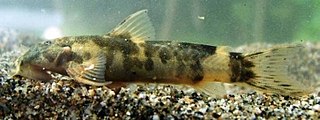
Astroblepus is a genus of fish in the family Astroblepidae found in South America and Panama. This genus is the only member of its family. These catfishes are primarily found in torrential streams in the Andean area. Astroblepus pholeter and A. riberae are troglobites adapted to living in subterranean water systems. These species are typically small, less than 10 cm (4 in). The largest species reaches 30 cm (1 ft). These fish have suckermouths like those of loricariids. They have two pairs of barbels, maxillary and nasal. The dorsal fin spine lacks a locking mechanism. These fish also have odontodes, tiny teeth on their skin. All species exhibit a conical, pointy type on their fin rays like that found in other loricarioids; other species also exhibit a blunt type that is only found on their skin.
Astroblepus boulengeri is a species of catfish of the family Astroblepidae. It can be found on the Amazon River.

Astroblepus chapmani is a species of catfish of the family Astroblepidae. It can be found in the Magdalena River in Colombia.
Astroblepus chimborazoi is a species of catfish of the family Astroblepidae. It can be found in Ecuador.

Astroblepus cyclopus is a species of catfish of the family Astroblepidae. It can be found on Ecuador and Colombia.
Astroblepus festae is a species of catfish of the family Astroblepidae. It can be found on south Ecuador.
Astroblepus formosus is a species of catfish of the family Astroblepidae. It occurs only on a short stretch of the Ucayali River in Peru.

Astroblepus frenatus is a species of catfish of the family Astroblepidae. It can be found in the Magdalena, Orinoco and Catatumbo river basins in Colombia. A. frenatus is a carnivorous speciesand it is a habitat specialist which has a requirement for highly oxygenated water. This means that it is sensitive to changes in oxygenation levels and water temperatures. It may also be affected by the introduced rainbow trout but overall there is very little data about the status of this species.

Astroblepus grixalvii is a species of catfish of the family Astroblepidae. It can be found in Colombia and Ecuador.

Astroblepus guentheri is a carnivorous species of catfish of the family Astroblepidae. It can be found in rainforest streams in the basin of the Magdalena-Cauca rivers and in some Pacific slope rivers in Colombia. It is an uncommon and not well studied species.

Astroblepus heterodon is a species of catfish of the family Astroblepidae. It can be found in the rivers which drain the Pacific slope of Colombia where its populations are vulnerable to pollution from gold mining.

Astroblepus homodon is a species of catfish of the family Astroblepidae. It can be found in Colombia.
Astroblepus labialis is a species of catfish of the family Astroblepidae. It can be found on the Marañón River in Peru.
Astroblepus latidens is a species of catfish of the family Astroblepidae. It can be found on the Meta River in Colombia and Venezuela.
Astroblepus longiceps is a species of catfish of the family Astroblepidae. It can be found on the Madeira River in Brazil and Bolivia.
Astroblepus longifilis is a species of catfish of the family Astroblepidae. It can be found on the Huallaga River in Peru.
Astroblepus rengifoi is a species of catfish of the family Astroblepidae. It can be found on the Atrato River in Colombia.
Astroblepus stuebeli is a species of catfish of the family Astroblepidae. It is endemic to the Lake Titicaca basin, in Bolivia and Peru.
Astroblepus theresiae is a species of catfish of the family Astroblepidae. It can be found on Ecuador.
Astroblepus ventralis is a species of catfish of the family Astroblepidae. It is found in Colombia, in the Dagua River and Pacific coast.






